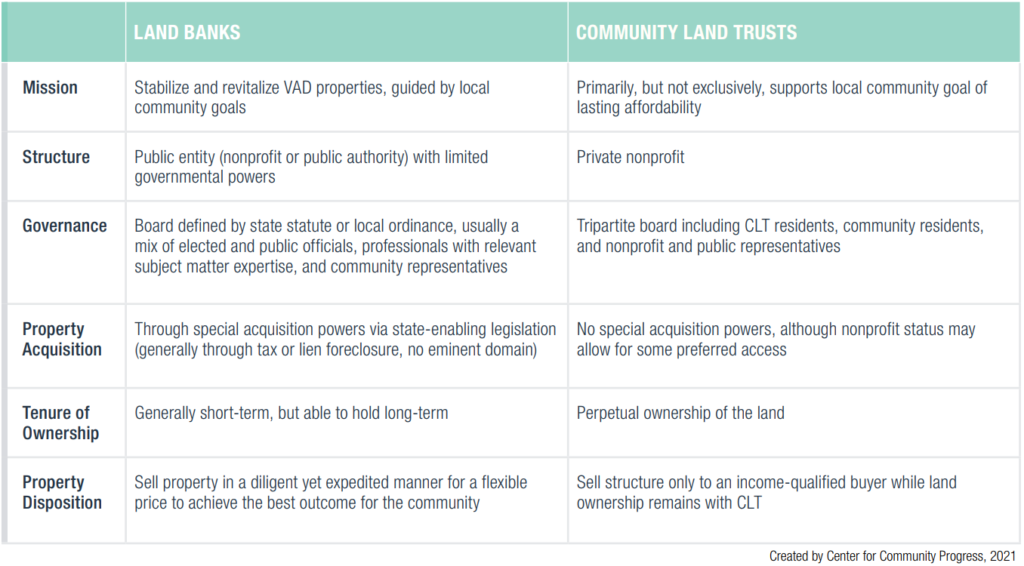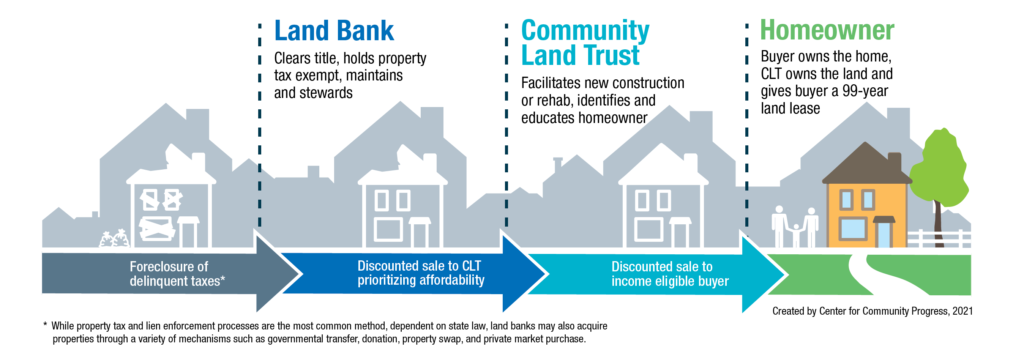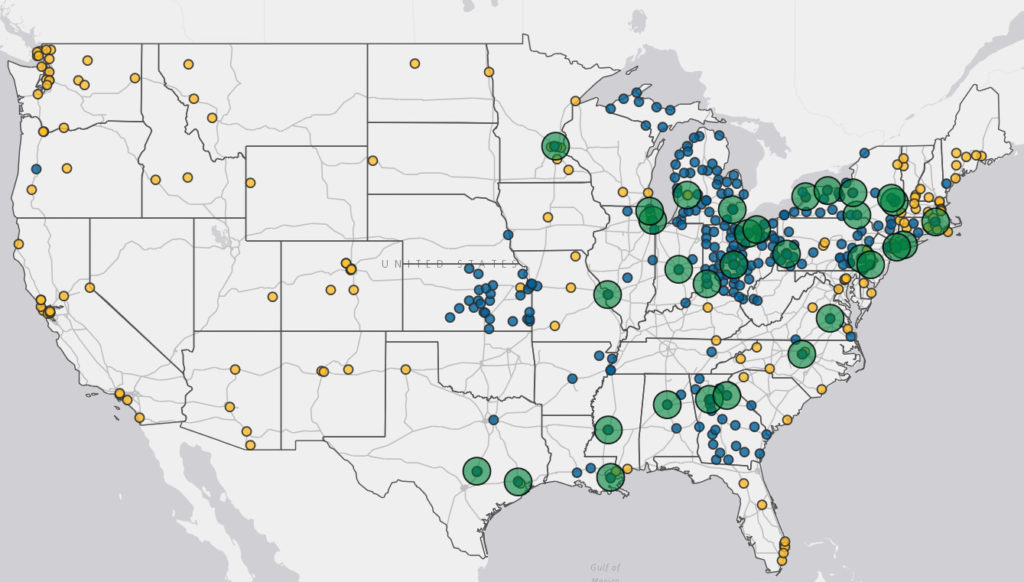A Pioneering Approach to Bring a Legacy of Quality, Affordable Housing to Communities
November 15, 2021

Communities nationwide struggle with inventories of properties that are causing harm—properties that are vacant, abandoned, and deteriorated (VAD). Often these properties are concentrated in areas where an intentional history of racist policies resulted in disinvestment and denied homeownership for many Black families—a loss of wealth that has compounded across several generations.
The COVID-19 pandemic has exacerbated these racial disparities and community destabilization. While much is still unknown about the pandemic’s long-term impact, many neighborhoods are anticipating an increased inventory of VAD properties as a result of evictions and mortgage and tax foreclosures.
As with the Great Recession, another wave of outside investor activity will likely cause dramatic changes in land ownership in communities nationwide. As a result, profound systemic changes and resources will be needed to ensure that residents can control the capital and capacity required to stabilize and control land in their communities.
Land banks and community land trusts (CLT) are two entities that, in concert, can help reverse the trajectory of disinvestment and unlock a pipeline of VAD properties to provide quality, affordable housing for future generations that prioritizes community ownership and control.
Two Critical Tools
Land banks are public entities with unique governmental powers, created pursuant to state-enabling legislation, that are solely focused on converting problem properties into productive use according to local community goals.
Whereas, community land trusts are nonprofit organizations, governed by CLT residents and nonprofit and public representatives, that provide permanent community control of land and affordable housing.

Working in concert, a land bank can leverage its unique property acquisition powers to provide a pipeline of land or structures for a CLT to convert into quality, permanently affordable housing. In that manner, each entity is leveraging the other’s strengths.

A Pioneering Approach
Despite many communities having a land bank and a CLT, there are strikingly few examples of land banks and CLTs coordinating effectively and in a sustained manner. In an effort to spark more collaboration between these different, yet complementary entities, the Center for Community Progress recently released the first of its kind publication focused on the opportunity for land bank and CLT partnerships.

Places like Albany, New York; Atlanta, Georgia; and Columbus and Franklin County, Ohio are pioneering models of how these partnerships can support neighborhood stabilization and prevent displacement of vulnerable residents. Reflecting on their land bank and CLT partnerships, local land bank leaders had this to share:
- “Evidence continues to emerge that land banks and CLTs have multiple synergies in their capabilities and programs. In recognition of that, the Metro Atlanta Land Bank and the Atlanta Land Trust have entered into a formal partnership to intentionally work to increase the impact and effectiveness of our efforts to deliver affordable housing in the city of Atlanta,” said Christopher Norman, executive director of the Metro Atlanta Land Bank.
- ‘‘When the two entities [land banks and CLTs] recognize their relevant strengths and cooperate the entire community benefits. As a land bank and community land trust, our operations are streamlined, and our programs are more creative and impactful,” said Curtiss Williams, president and CEO, Central Ohio Community Improvement Corporation – Franklin County Land Bank.
- “Land banks and community land trusts are among the most proven and progressive community development tools in the nation. Partnerships between land banks and land trusts can help communities…build more equitable, resilient, inclusive, and affordable neighborhoods as they recover from the disproportionate impacts of the Great Recession and COVID-19,” said Adam Zaranko, president of the New York Land Bank Association and executive director of the Albany County Land Bank.
5 Keys to Successful Partnerships
Following discussions with communities across the country, we have found five key elements for successful land bank and CLT partnerships:
- Leading with Racial Equity: Strong political and community leadership that demonstrates a commitment to racial equity and acknowledges the impact systemic racism has and continues to have on communities that suffer from disinvestment and pledges their shared responsibility to address this inequity moving forward. Establishing multi-racial leadership that is actively engaged with, learning from, and seeking to share and turn over power and resources to Black leadership and Black-led organizations begins to address the needed systemic changes.
- Committing to Quality, Affordable Housing: Strong political and community leadership that not only acknowledges the importance of quality, affordable housing but also leverages its power and influence to direct critical resources towards its production and preservation. This intentional commitment enables the level of support and resources needed to transform disinvested properties into affordable housing.
- Prioritizing Authentic Engagement and Partnerships: The engagement of residents and community stakeholders is critical, particularly in disinvested neighborhoods. Holding explicit discussions about the challenges facing their community is vital and how land banks and CLTs are both tools that must be aligned within a larger network of partners and resources. Open and honest discussions like these build trust yet manage expectations about what is needed to stabilize and revitalize communities.
- Leveraging Unique Powers and Strengths: When land banks have comprehensive state and/or local land banking authority, they can leverage unique powers to unlock a specific subset of properties that are causing the most harm to a community and prioritize the transfer of these properties to a CLT. Likewise, one of the unique strengths of CLTs is the long-term stewardship of land and ensuring the pipeline of properties acquired from a land bank continues to serve the community in perpetuity—directly aligned with the land bank’s core mission.
- Dedicating Flexible Funding and Capital: When properly capitalized, land banks and CLTs can have the necessary capacity to bring their work to scale and consider additional mechanisms to acquire property before the market heats up. This type of flexible financial support, particularly in the form of direct grants, can also leverage subsidy on the back end, given the costs associated with transforming VAD properties into quality, affordable housing for generations to come.
Interested in exploring a partnership in your community? Check out these resources:
- Publication: Land Banks and Community Land Trusts: Partnering to Provide Equitable Housing Opportunities Now and for Future Generations
- One-Pager: Land Banks and Community Land Trusts
- Map: Land Banks, Land Banking Programs, and CLTs – Locations and Potential Shared Service Areas
- Webinar: Our first Cornerstone webinar in 2022 (February 24th at 12 pm ET) will discuss land bank and community land trust partnerships. Join our mailing list to receive registration updates.
Blog authored by Kim Graziani, Center for Community Progress Technical Assistance Senior Advisor
Subscribe to join 14,000 community development leaders getting the latest resources from top experts on vacant property revitalization.
